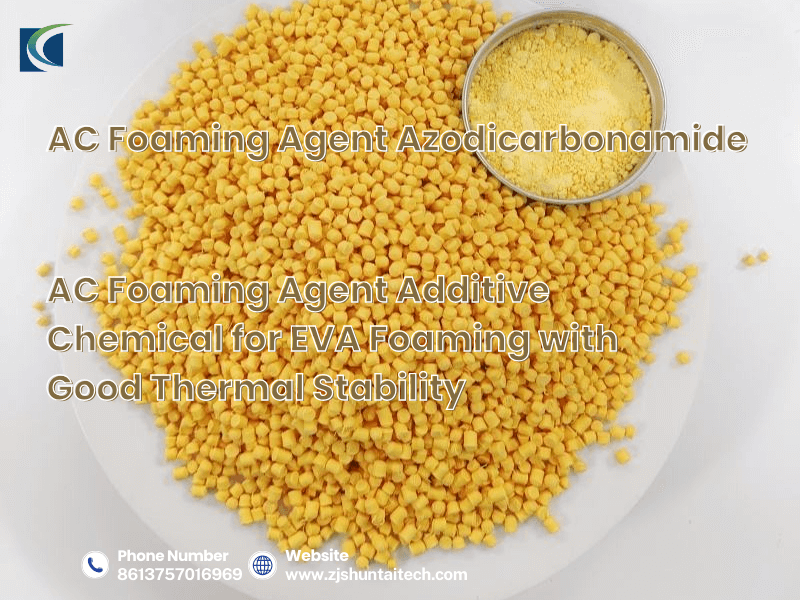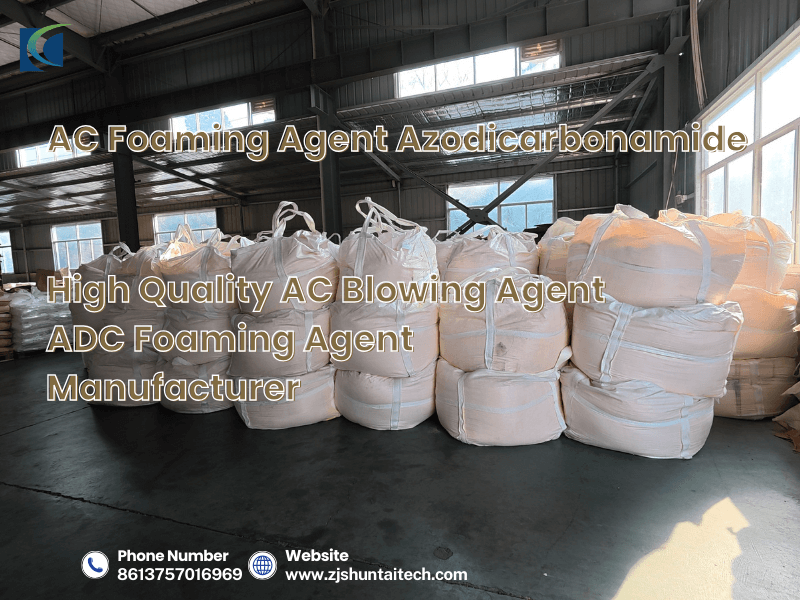In the field of polymer foaming, AC blowing agents (azodicarbonamide derivatives) serve as the core raw material determining the quality of foam products. From rigid plastic insulation materials to flexible foam cushioning pads, their performance directly impacts key product metrics such as density, thermal insulation, and durability.For manufacturers and R&D personnel seeking to achieve breakthroughs in foam product performance, a deep understanding of the three core parameters of AC blowing agents—gas generation capacity, particle size distribution, and decomposition temperature—along with their synergistic interactions is essential.

AC foaming agent, fully known as azodicarbonamide, is a chemical foaming agent that releases gases such as nitrogen and carbon dioxide under heating conditions. It is widely used in the foaming processing of polymeric materials like polyethylene, polypropylene, and rubber. Its core function is to form uniform foam cells within the polymer through gas expansion, thereby reducing product density and enhancing thermal insulation and cushioning properties.
From a chemical structure perspective, AC foaming agent molecules contain azo groups (-N=N-), which undergo decomposition reactions at specific temperatures to release large volumes of gas.Based on purity and modification methods, they are categorized into industrial-grade AC blowing agents (95%-98% purity), high-purity AC blowing agents (>99% purity), and modified AC blowing agents (e.g., composite products with added catalysts or stabilizers).Different types of foaming agents suit distinct applications. For instance, high-purity products are better suited for food packaging where residual impurities are critical, while modified products meet specific processing temperature requirements.
AC foaming agents find applications across nearly the entire polymer processing industry. In rigid plastics, they are used to produce PVC insulation panels and PS foam packaging materials.In flexible materials, they foam EVA shoe soles and rubber seals; additionally, they serve in building insulation and automotive interior foams. In the automotive sector, seat foams produced with performance-optimized AC blowing agents reduce weight by 15%-20% while enhancing comfort and durability.
Unstable AC blowing agent performance directly causes defects in foam products.For instance, insufficient gas generation leads to excessively high product density, increasing production costs; uneven particle size distribution causes inconsistent cell sizes, affecting product appearance and mechanical properties; and mismatched decomposition temperatures with polymer processing temperatures may result in “under-foaming” or “over-foaming” issues. Therefore, mastering the performance parameters of AC blowing agents is a critical prerequisite for ensuring end-product quality.
Gas yield refers to the volume of gas released per unit mass of AC blowing agent during decomposition (typically measured in mL/g), serving as the core indicator determining foam expansion rate. Common gas yields for AC blowing agents in the industry range from 200-250 mL/g, with premium products achieving over 260 mL/g.
Per ASTM D297-93, gas yield testing must be conducted under specified temperature (typically 200-220°C) and pressure conditions. It is calculated by collecting and measuring the volume of gas produced during decomposition.The international standard ISO 815 similarly specifies testing methods to ensure comparability of results across laboratories. In actual production, gas generation must be adjusted according to product requirements. For instance, high-reactivity AC blowing agents are selected for low-density foams, while gas generation must be controlled for high-density structural foams.
Gas yield is not a fixed value and is influenced by multiple factors. First is raw material purity; impurities occupy space within the blowing agent molecules, reducing the effective gas release. For example, a purity decrease from 98% to 95% may reduce gas yield by 10%-15%.Second, storage conditions: Humid environments cause AC blowing agents to absorb moisture, inhibiting decomposition reactions. Therefore, they must be stored in dry, cool conditions, with a shelf life typically not exceeding 12 months. Additionally, compatibility with polymers affects gas generation. If the blowing agent is unevenly dispersed within the polymer, some gas may become trapped inside the polymer and unable to release, resulting in actual gas generation lower than the theoretical value.
Foam density exhibits a significant inverse correlation with gas yield—higher gas yield results in lower foam density. The calculation formula can be simplified as: Foam Density = (Polymer Mass + Foaming Agent Mass) / (Polymer Volume + Gas Volume).Taking PP foam production as an example: when using AC blowing agent with a gas generation rate of 240mL/g at a 3% addition rate, foam density can decrease from 0.9g/cm³ to 0.3g/cm³. Increasing the gas generation rate to 260mL/g at the same addition rate further reduces density to 0.25g/cm³, significantly lowering raw material costs.
When encountering low gas yield issues during production, investigate from three angles: First, inspect raw material purity using infrared spectroscopy or chromatography to detect impurities. Second, verify storage conditions by testing the foaming agent's moisture content; if exceeding 0.5%, drying treatment is required. Third, optimize processing techniques by adjusting mixing speed and duration to ensure thorough dispersion of the foaming agent within the polymer.For example, one company experienced uneven foaming agent dispersion due to insufficient mixing speed, resulting in an actual gas generation utilization rate of only 80%. After adjusting the mixing speed, the utilization rate increased to over 95%.
The particle size distribution of AC foaming agents directly impacts bubble formation and growth. Excessively large particles result in coarse, unevenly distributed bubbles, while excessively small particles may cause agglomeration, similarly compromising foam quality. The industry typically uses D50 (median particle size) as the core metric, with a common range of 5-15μm.
Particle size distribution is measured via laser diffraction or sieve analysis, with core metrics including D10 (10% of particles smaller than this value), D50 (50% of particles smaller than this value), and D90 (90% of particles smaller than this value). High-quality AC blowing agents should exhibit a D90-D10 < 10μm distribution to ensure uniform particle size.
During foaming, AC foaming agent particles serve as the “nuclei” for cells—each particle decomposes to form one or more cells. Excessively large particle sizes concentrate gas release, promoting large cell formation. Conversely, excessively small particles tend to agglomerate, causing multiple particles to coalesce into a single large cell.Additionally, particle size variation causes uneven bubble growth rates. Rapid expansion of some bubbles compresses surrounding smaller ones, causing bubble rupture. For example, increasing D50 from 10μm to 20μm raises the coefficient of variation in foam product bubble diameter from 15% to 35%, severely impacting product appearance and mechanical properties.
Different polymers exhibit varying melt viscosities, necessitating selection of corresponding AC foaming agent particle sizes.For instance, PVC exhibits high melt viscosity, necessitating smaller particle sizes (D50=5-8μm) to ensure adequate dispersion within the melt. Conversely, PP's lower melt viscosity permits larger particle sizes (D50=12-15μm) to prevent excessive dispersion and unduly small cells.Mismatched particle size and melt viscosity may cause “cell coalescence” or “cell collapse.” For instance, using excessively small particles in PE foaming can result in cell diameters below 10μm, compromising the product's thermal insulation performance.
Industrial practice commonly employs laser diffraction analyzers to test the particle size distribution of AC foaming agents. Prior to testing, samples must be dispersed in anhydrous ethanol to prevent particle agglomeration from affecting results. During production, particle size can be controlled by adjusting grinding processes (e.g., pressure and rotational speed in jet milling). For instance, increasing jet pressure can reduce particle size from 15μm to 8μm.Additionally, adding dispersants (such as calcium stearate) can mitigate particle agglomeration and improve the uniformity of the particle size distribution.
Decomposition temperature refers to the temperature at which AC blowing agent begins significant decomposition and gas release. It must closely match the polymer processing temperature (e.g., extrusion or injection molding temperatures). If the decomposition temperature is too low, the blowing agent may decompose prematurely before polymer melting, causing gas loss. If too high, the polymer may solidify before forming cells.
The decomposition temperature of AC blowing agents is typically categorized into “initial decomposition temperature” (the temperature at which gas release begins) and “peak decomposition temperature” (the temperature at which gas release rate is highest). Common industry values are 190-200°C for initial decomposition and 210-220°C for peak decomposition.Processing temperatures vary by polymer type—e.g., PVC requires 160–180°C while PP demands 200–220°C—necessitating AC blowing agent selection based on polymer-specific decomposition temperature.
AC blowing agents undergo exothermic decomposition reactions, releasing heat during decomposition that may cause localized temperature spikes and compromise polymer thermal stability. To address this, the industry produces “endothermic modified AC blowing agents” by incorporating heat-absorbing decomposition components like sodium bicarbonate to balance reaction heat.For example, using endothermic AC blowing agents in PVC foaming can control local temperature fluctuations during processing within ±5°C, preventing PVC degradation.
Decomposition temperature is regulated by multiple factors. First, catalyst addition—such as zinc oxide or zinc stearate—can lower decomposition temperature by 10–20°C, making it suitable for low-temperature processing polymers (e.g., PVC). Second, plasticizer inclusion—certain plasticizers (e.g., di-n-octyl phthalate) reduce the decomposer’s decomposition temperature.Third, thermal history: if AC blowing agents undergo high-temperature storage, “premature activation” may occur, lowering the decomposition temperature. Therefore, prior to production, the actual decomposition temperature of the blowing agent must be tested via Differential Scanning Calorimetry (DSC) to ensure compatibility with the processing conditions.
Mismatched decomposition and processing temperatures can trigger multiple issues. For instance, using an AC blowing agent with a decomposition temperature of 230°C in PP processing causes the agent to remain largely undecomposed after PP melting, resulting in excessively high product density. Conversely, employing an agent with a 180°C decomposition temperature in PVC processing leads to premature decomposition before PVC melting, causing gas loss.Solutions include: selecting modified AC blowing agents (e.g., low-temperature or high-temperature types), adjusting processing temperatures (e.g., increasing or decreasing extruder temperatures), or adding catalysts or stabilizers to regulate decomposition rates.